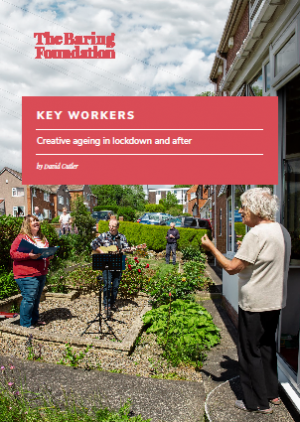I imagine that anyone reading this blog believes passionately in the right of everyone to be creative throughout their lives, including people living in care homes. The more difficult question is what needs to be done to ensure that this is a reality for all 410,000 people living in care homes as well as for the people caring for them?
From 2010-2019, the Baring Foundation focused its arts programme on creative ageing, and although the focus of our funding last year moved to creativity for people with mental health problems, we remain very interested in creative ageing.
So, as some of the restrictions that have created such problems in care homes have started to ease, we want to start to look forward towards what might be a more hopeful future. There is so much need for proper support and funding for social care in general, but as always, we will have a narrower focus on access to creativity and culture in a care home which is part of living a meaningful and enjoyable life there.
The question we would like to pose is: what would it require for all care homes to offer their residents access to relevant creative and cultural opportunities on a daily basis? And we are going to start off with England. Let’s unpack the question:
- ‘require’ – we want to understand how the system that supports such work is best organised: that includes the roles of staff, managers, artists and arts organisations, regulators and funders among others and how they work together;
- ‘all care homes’ – we have supported and seen so many examples of care homes doing great work on creative ageing, but this should be an entitlement for residents wherever they are living;
- ‘relevant’ – this includes a resident’s personal tastes, be that opera or pop music, their background or cultural preferences, and their physical and mental capacity to take part;
- ‘creative and cultural opportunities’ – this includes both being able to participate creatively but also to appreciate work as an audience member;
- ‘daily basis’ – if I like singing I don’t want to wait for a Christmas carol concert and if I am interested in poetry, a couple of workshops a year will leave me dissatisfied, but the explosion of online provision over the last year means that daily access to opportunities is no longer unrealistic.
We will start off by getting the views of care homes residents and care workers as to what good should look like. We don’t want this to be a remote exercise but one that is true to everyday experience and hopes. To do this we have commissioned the National Activity Providers’ Association (NAPA) to carry out consultations over the summer which they will publish on National Arts in Care Homes Day on 24 September this year.
This will lead on to a second stage where we will issue an independent discussion document about how the different parts of the system can best play their parts and be resourced to do so. We will be very interested to hear your thoughts as we go along. Lastly, we will advocate for the conclusions and ask for your support in this.
The last year has been almost unbearably tough, especially for people living and working in care homes. A more creative place to call home is part of the future they deserve.
To keep up-to-date and opportunities to get involved in this conversation:
